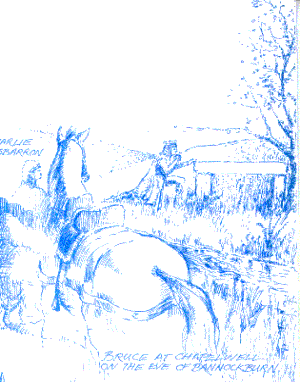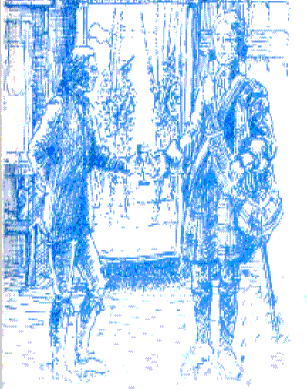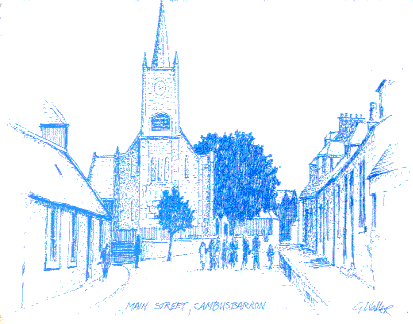Byegone Days of Cambusbarron
The following are extracts from the book "Bygone Days in Cambusbarron" and have been reproduced here with the kind permission of the Author Mr P.T. Paterson, a resident in Cambusbarron.
On a cold
February morning in 1879, work was brought to a halt at Drummond’s Coney
Park Nursery, Cambusbarron. Some of the men digging through a mound of
earth, in the centre of the nursery, had struck an obstacle. When they
cleared back the soil, the gardeners discovered several stones placed
against and over each other as if to form a small wall sealed by a
yellowish clay the Coneypark men had not seen before in their nursery.
 And
when they broke through this mound the men were astonished at what they
found: a human skeleton. It was propped against the inside wall. It had
been there for 2,500 years. And as fresh air displaced the fetid
atmosphere of the tomb, and the intruders stood transfixed, the skeleton
disintegrated before their eyes.
And
when they broke through this mound the men were astonished at what they
found: a human skeleton. It was propped against the inside wall. It had
been there for 2,500 years. And as fresh air displaced the fetid
atmosphere of the tomb, and the intruders stood transfixed, the skeleton
disintegrated before their eyes.
Through its circumstances were
fairly dramatic, this find, the tomb of some important person, (Map
Reference 783926) was only one of several made in the locality during
the second half of the nineteenth century which suggest that some kind
of community was already established in Cambusbarron during the Bronze
Age - from 1700 to 500 B.C., in the Stirling area. At least four other
cists - a cist being a tomb consisting of a stone chest covered with
stone slabs - were found in the stretch of land between Birkhill and the
Kings Park: two were discovered in the garden of Birkhill House (780926
and 779926), one containing bones and an ornamental urn, possibly a food
vessel; a partly destroyed cist was found in Birkhill sand-pit (779925),
and a broken urn in the sand-pit and adjoining Douglas Terrace (782920).
Besides these cist finds, several other pieces of Bronze Age pottery
have been discovered in the Cambusbarron area, including beakers and
cinerary urns (i.e. urns containing ashes of the dead). Unfortunately,
the exact circumstances surrounding these discoveries, perhaps as many
as ten, have not been recorded, though most of the relics are preserved
in either the Smith Institute or the National Museum of Antiquities in
Edinburgh.
A final interesting, if enigmatic, Bronze Age relic
is the cup-and-ring marking in the Kings Park where it overlooks the
village. This consists of a natural stone marked by what appears to be a
cup 1½ inches in diameter and ½ inch deep surrounded by a ring 5 inches
in diameter and ¼ inch deep. Last officially inspected in 1958, it was
then described as being near the summit of the crag that borders the
Park and lies behind Douglas Terrace, some 45 yards east of a seat on
the summit. The map reference is 783930, but the hopeful searcher will
have much difficulty in discovering its whereabouts due to the thick
growth of turf and bushes in the area. Its significance, like others
found throughout the British Isles and the continent, remains a mystery
though one theory suggests that the markings may symbolise the sun (cup)
and its heat (ring) and that they were produced in connection with the
activities of the Bronze Age smiths and smelters.
About the
earlier inhabitants of Cambusbarron before the Bronze Age dwellers,
little is known and we have to rely even more on inference and guess
work. After the Ice Age, some 8,000 years ago, some areas of present day
Cambusbarron were under water - part of the great post-glacial flood
created by the melting of the ice; the River Forth is a modern
descendant of that sea. Much of the flat, low-lying land is a noticeable
feature of the Forth Valley, both to the east and west of Stirling once
formed the bed of this great sea loch.

Numerous fish fossils and remains have been recorded in the area,
the most interesting of which was the 50 ft. skeleton of a whale found
at West Carse on Touch estate during the construction of the present
Dunbarton Road in the early years of last century. The present Touch
Road, in fact, as it leaves the village from the West End, follows the
line of the prehistoric raised beach of the Forth and a great,
semi-circular bay was once formed behind Touch House, Gartur House and
Hillhead Farm. From approximately 3,000 B.C. the water gradually receded
until by Christian times it had reached the present shoreline of the
Forth. And it is the carse clay of the one-time sea that has provided
evidence of the earliest human presence in the Stirling area in the form
of primitive tools made from bone and antlers. "Kitchen middens"
alongside testify to the diet of these people of the Mesolithic Period
("Meso - lithic" - middle stone age, i.e. they lived 3,500 years ago):
mussels, cockles, periwinkles and whelks, fish and perhaps the
occasional luxury of a stranded whale. A heavy round stone with a hole
in the middle, unearthed by Mr. W. McEwan a few years ago from the
fields of his Hillhead Farm, may well be a net-sinker used by these
early fishermen. A barked flint arrow-head from Murrayshall Lime Kilns
in 1911, a clay-stone axe from Whitehouse Farm in 1893 and an axe-head
from Greystale Farm in 1880 are the only other recorded finds in the
locality which may date from Stone Age times.
Whether or not Stone
Age Man settled for any length of time in what is now Cambusbarron, is
impossible to say. It may well be that, driven to ensure a steady food
supply, he was nomadic and, living in rough brush-wood and reeded huts
or tents, he wandered up and down the southern shoreline of the
prehistoric Forth. The first farmers, possibly the forefathers of those
who left the Coneypark and Birkhill relics, came to the area in
approximately 3,000 B.C., coinciding with the receding waters of the
Forth. Attracted by lighter sands and gravel which supported a more open
vegetation cover than the heavier, if ultimately more productive, clay
soil, these early farmers ignored both the re-emerging carse lands — in
later centuries to become some of the best farmland in Scotland— and the
more exposed uplands, to settle on the lower, better-drained hill slopes
of the region, onland such as that around Cambusbarron and, in
particular, that of the Touch area which has up to fairly recent times
supported a number of farms. Not until the invention of the heavy plough
in the Iron Age did the farmers move down to the carse.
The dwellings
of these people, though still extremely primitive, were more permanent
than the wattle and daub huts of their predecessors, and consisted of a
singular rectangular room with stone and mud walls and a thatched roof
held up by central timber posts. At one end there would be a door, but
no windows, the only outlet being in the centre of the roof for smoke
from the fire. Unfortunately, no finds of such dwelling places have been
made in our area though they are recorded elsewhere. A third phase in
the prehistory of the Cambusbarron area is marked by a number of Iron
Age sites, particularly of the hill fort and dun variety which are found
exclusively to the west and south west of the village. That no such
remains are presently known inside the village itself does not preclude
their earlier existence: their sites may have been built upon over the
centuries or have been destroyed by the plough or - a common fate for
many ancient monuments - they may have been quarries for later builders
and their material plundered.
 A
fourth possibility is that the comparatively more gentle slopes of
Cambusbarron did not impress the builders of these duns and forts as
having the same forbidding defensive qualities as the clifftops and
steep summits of the Murrayshall, Sauchie Crags and Gillies Hill areas.
It is on the west-facing crag of Gillies Hill that is recorded the
nearest of these hill forts to the village. It lay just back from the
cliff face at a point where the crags are interrupted by a transverse
gully (769917). The other Gillies Hill site is the Wallstale Dun
(774909) which lies on a south-projecting spur of the woodland 160 yards
north of Wallstale Farm. This was once known to local people as "The
Temple" and was a favourite picnic spot in Victorian days. Duns were
generally smaller than hill forts and, varying greatly in size and
shape, date of construction and duration of occupation, seem to have
been used for defence.
A
fourth possibility is that the comparatively more gentle slopes of
Cambusbarron did not impress the builders of these duns and forts as
having the same forbidding defensive qualities as the clifftops and
steep summits of the Murrayshall, Sauchie Crags and Gillies Hill areas.
It is on the west-facing crag of Gillies Hill that is recorded the
nearest of these hill forts to the village. It lay just back from the
cliff face at a point where the crags are interrupted by a transverse
gully (769917). The other Gillies Hill site is the Wallstale Dun
(774909) which lies on a south-projecting spur of the woodland 160 yards
north of Wallstale Farm. This was once known to local people as "The
Temple" and was a favourite picnic spot in Victorian days. Duns were
generally smaller than hill forts and, varying greatly in size and
shape, date of construction and duration of occupation, seem to have
been used for defence.
They were distinguished by their
comparatively small size and disproportionately thick walls. Today’s
interested antiquarian, however, is inevitably disappointed when he
arrives at one of the sites: due to extensive quarrying by later
generations, the duns and hill forts have lost most of their stonework
and it is often difficult to imagine them as they once were. With one
notable exception, this is true of the remaining sites in the
Murravshall/ Sauchie/Touch area: there is Wester Craigend, or Sauchie
Fort, (767906) lying approximately 360 yards west of Craigend House, on
the high cliffs above the Bannockburn (or Limestone Burn, as it has been
known to generations of Cambusbarron people); Touchadam Fort, (767909)
now merely a rocky mound just to the north of Limestone Road at the
entrance of Murrayshall Farm. This site was known by locals in Victorian
times as "The Camp"; the Touch Muir Dun, in open moorland which descends
gradually southwards to the left bank of the upper reaches of the West
Burn 30 yards away. It is 770 yards N.N.W. by N. of what was once the
boathouse of No.4 loch, Touch Muir. It is 42 ft. in diameter and a
ruined stone wall varying in thickness between 8 and 12 ft. is now a
grass banking though the eastern entrance is well defined; there are two
dun sites on the Castlehill area of Touch, the first (766908) on a rocky
outcrop 760 yards S.E. of the ruins of Castlehill Farmhouse. All the
stones were removed last century. The second (760909) is on a rocky
knoll a quarter of a mile south of the same ruined farmhouse.
Four other prehistoric sites in this area, though not apparently duns or
hill forts, should be recorded. One is Woodside Homesteads (753912) and
this lies in the uppermost of the cultivated fields of Woodside Farm
some 650 yards SW. of this Farmhouse. It is D-shaped in plan and is 170
ft. in length E. to W. A group of small huts would have stood within the
boundaries of the homestead and the stone foundations of two may still
be observed. The second is described by the Royal Commission of Ancient
Monuments as a "Mound at Touch" (750931) lying beside the farm road
running south from the former West Lodge of Touch, 300 yards from that
building. It may be a denuded cairn. Thirdly there is an enclosure on
Touch Muir, consisting now of only a few boulders, 100 yards W.N.W. from
Touch Muir Dun, near the West Burn (722920). And finally indeterminate
ruins (749930) have been found on open ground 400 yards south of Touch
West Lodge. They may be the remains of an ancient farmhouse. The most
impressive Iron Age site in the area is, however, the dun at Castlehill
Wood. This lies 1,100 yards W.S.W. of the ruins of the Castlehill
Farmhouse and is oval shaped, measuring 75 ft. from N.E. to SW. by 50
ft. transversely within a dry stone dyke 6 ft. thick situated at a
height of 650 ft. above sea-level, the dun commands a fine view of the
surrounding countryside and its original occupants would have been able
to maintain visual contact with most of the other forts in the area.
Remains of fires have been found, as have various small artifacts which
suggest that occupants lived in the adjacent area, possibly in wattle
and daub shelters. More interestingly, fragments of Roman glass have
also been uncovered, dating the structure to the first or second century
A.D. and suggesting that the invading Romans may have taken temporary
occupation of the fort; alternatively, the fragments may be the result
of invader/native trade or battle plunder.
The Romans themselves
have left almost no traceable impact on Cambusbarron. A local 19th
Century tradition that Birkhill House was built on the site of a Roman
villa seems unlikely; a record of fragments of a Roman urn being found
in Cambusbarron Sandpit, formerly to the west of Birkhill House, may
have more validity or may be the result of confusion with Bronze Age
relics there; and the 1841 Statistical Account suggestion that the
foundations of a road uncovered at Bearside Farm in the 1830s was Roman,
is now regarded as doubtful, though the Account contended that the road
might lead to Castlehill Dun or to a ford over the Forth at Kildean.
(More recent research suggests that the main Roman road north came
through St. Ninians then veered slightly to the west of Stirling through
Laurelhill Place and Snowdon Place, and then probably to Kildean. The
Iron Age duns and hill forts are the final remnants of Cambusbarron’s
prehistory. In fact, spanning as they do they gulf between BC and AD
they are bridges in time between the distant days of our earliest
ancestors, and the beginnings of what we regard as recorded history.
Despite the ravages of the intervening millennia, these very old stones,
ancient relics of Cambusbarron’s earliest days, profoundly affect the
imagination; we think of their silent survive over the centuries, the
lost worlds that surged and fell around them, and most of all, of the
people who left them.